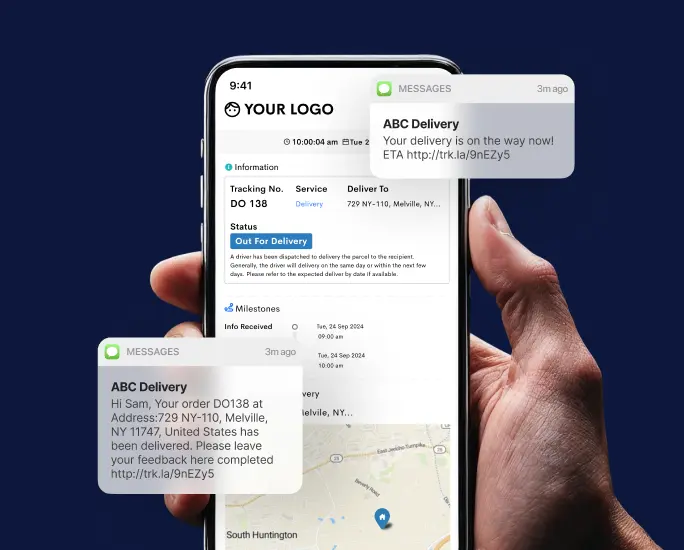Are you struggling to keep up with managing queues? Do you have long wait times and unhappy customers? You need to start using a customer service queue management system.
A queue management system will help you keep track of all your customer inquiries, and ensure that each customer is attended to in a timely manner.
In this blog post, we will give you 10 ways how you can manage queues efficiently and effectively. So, read on if you want to keep your customers smiling!
How To Manage Customer Service Queues More Effectively In 10 Simple Steps
In order to implement the suggestions below, you will need a vehicle tracking app with certain features, such as those included in Detrack. The relatively small initial investment in such a system will pay huge dividends over time.
1. Target Faster Response Times
This may sound like an obvious piece of advice and one you would already have implemented if it were possible but with a fully-featured fleet management app such as Detrack, you’ll finally be able to act on it.
With automatic emails sent to customers on the completion of each delivery, your queue service will instantly improve: the volume of calls will be reduced because many customers will already have the information they require.
You can also add each customer as a sub-user to your vehicle tracking system, granting them access to real-time location information for their own deliveries.
2. Faster Processing Times
Accelerate call processing times considerably by providing your customer service agents with all the information they need through a dispatch software solution. The ability to see the location of every truck at any time and to access detailed delivery information for each consignment will allow them to answer customer queries quickly and accurately.
With a vehicle tracking system in place, you will have access to a wide range of information and data that can be used to streamline your operation. You will know the location of each vehicle at all times, meaning you can better predict arrival times and plan accordingly.
In addition, many apps offer proof of delivery (POD) features that automate the process of collecting customer signatures and photos. This information can be automatically emailed to the customer, saving valuable time.

3. Proactive Communications
When looking at how to build a queue management system, many companies miss one of the most important steps: contacting customers before they contact you. With the ability to contact delivery recipients from within the mobile app, Detrack enables drivers to inform customers of delays instantly, negating the need for them to call your service agents.
Not only will this reduce the volume of inbound calls, but it will also lead to a great improvement in the service you provide. Customers appreciate proactive communications, and it will show that you are on top of your game.
In addition, automated status updates can be sent to any email address or mobile phone number, keeping all interested parties up-to-date with the latest delivery information.

4. Prioritise Customer Service Requests
Managing queues can be a tricky business. On the one hand, you want to ensure that customers are served in a timely manner. On the other hand, you don’t want to create an undue sense of urgency or frustration.
One way to strike the right balance is to prioritize customer service requests. This means that you should attend to those requests that are most urgent first, such as those relating to medical emergencies or safety concerns.
By attending to these requests first, you can help to ensure that customers feel safe and valued. In addition, prioritizing customer service requests can help to reduce overall waiting times, as customers who are waiting for less urgent requests will not need to wait as long.
Ultimately, prioritizing customer service requests is all about striking the right balance between customer satisfaction and efficiency.
5. Directing Calls to the Right People
One of the biggest advantages of a work queue management system that can access detailed information from an advanced dispatch software solution is the way calls are handled once they are answered.
If you have researched how to build a queue management system that increases efficiencies in all areas, you are sure to have come across this advice before. Using the information from your dispatch software, you can make sure that each call is routed to the person most capable of dealing with it.
For example, if a customer is enquiring about the status of their delivery, the call can be directed to the driver so that they can provide accurate information. This not only reduces the amount of time spent on each call but also ensures that the customer receives the best possible service.
6. Use A Queue Management System
There are many different types of queue management systems available, each with its own advantages. You will need to select the one that best suits your needs, but we would recommend using a system that can integrate with your dispatch software.
This is because such a system will be able to access all the information it needs from your centralised database, meaning that calls can be processed quickly and efficiently. In addition, it will be able to automate many of the tasks associated with call processing, saving valuable time.
Managing queues is also beneficial as it will allow you to track performance over time. This information can be used to make improvements to your operation, leading to even better service in the future.
7. Make Wait Time Clear – And Stick To It
Queues are an inevitable part of daily life, whether we’re waiting to pay for our groceries or to board a plane. And while queues can often be frustrating, there are ways to make the wait time more bearable for everyone involved.
First and foremost, it’s important to be clear about the expected wait time. If customers know how long they will have to wait, they will be less likely to become impatient and more likely to cooperatively queue. Furthermore, it’s important that businesses stick to the stated wait time as closely as possible.
Frequent announcements about delays or changes in the estimated wait time will only serve to frustrate customers further. By following these simple guidelines, businesses can help turn the experience of waiting in line from a negative one to a more tolerable one.
8. Make The Customer Journey Clear
When it comes to managing queues, clarity is key. Customers should always understand where they are in the queue and how long they can expect to wait. This can be accomplished in a number of ways, such as by providing visual cues (e.g., signs or displays) or auditory cues (e.g., announcements or music).
By clearly signposting the route that customers need to take, and making sure that they understand where they are in the queue at all times, businesses can help to reduce frustration and improve the overall customer experience.
In addition, by ensuring that staff are trained in how to deal with queues, businesses can help to ensure that they are managed effectively and efficiently. By making the customer journey clear, you can help reduce frustration and improve the overall experience.
9. Offer Scheduling
When customers are forced to wait in line, they often become frustrated and impatient. This can lead to angry outbursts and even bad publicity. One way to help alleviate this problem is to offer to schedule when managing queues.
There are a few different ways to offer scheduling. One is to allow customers to schedule online or through a mobile app. Another is to have a representative take scheduling information over the phone. Finally, some businesses have kiosks where customers can select an available time slot.
By allowing customers to schedule their time in line, you can help to reduce their anxiety and frustration. In addition, it can also help to increase efficiency by ensuring that customers are being served in a timely manner.
Scheduling can be used in a variety of queue-based situations, such as restaurants, retail stores, and medical offices. When implemented correctly, it can help to improve the customer flow and reduce wait times.
10. Use Queue Data To Implement Changes
As anyone who has ever waited in line knows, queues can be frustrating. They are often slow, inefficient, and unpredictable. However, there is a way to use queue data to help manage queues and make them run more smoothly.
By studying queue data, managers can identify patterns and trends that can be used to improve the flow of traffic. For example, if the data shows that a particular queue is always congested at a certain time of day, the manager can make changes to the schedule or staffing levels to alleviate the problem.
Similarly, if the data shows that a particular type of customer is always causing delays, the manager can take steps to address the issue. By using queue data to inform decision-making, managers can help to make queues more efficient and predictable.
In short, queue data can be a valuable asset for anyone responsible for managing queues. By tracking key metrics and using the information to make changes, it is possible to improve the customer experience and keep things running smoothly.
Conclusion
Providing good customer service is essential for any business. Not only does it create repeat customers, but it also helps to attract new business. One of the most important aspects of customer service is managing queues effectively.
By understanding the needs of your customers and implementing the right queue management strategy, you can provide a more efficient and satisfying customer experience.
In addition, by monitoring your queues on a regular basis, you can identify potential problems and take corrective action before they result in dissatisfied customers. By following these simple tips, you can help ensure that your customers always have a positive experience with your business.
Once you start to use Detrack dispatch software, you’ll be able to grapple with how to manage customer service queues more effectively in ways that were simply not possible in the past. Your customer queue service will improve in leaps and bounds and your service agents will find it much easier to do their jobs efficiently.
Manage your customer service queues with Detrack
If you would like to enjoy all the benefits of queue management listed above, contact us now for more information on our industry-leading global dispatch software. Alternatively, you can create an account and try Detrack today (with limited features).



















